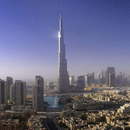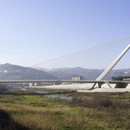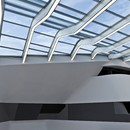Biography
Spanish-born, naturalized Swiss, architect and engineer Santiago Calatrava (1951) attended Valencia School of Art and graduated from the Polytechnic University, Valencia, in 1974. Subsequently he also graduated in Civil Engineering from the Federal Polytechnic School in Zürich.His engineering thesis entitled "Foldability of Space Frames”, focused on the compression of geometric models in space and marked a significant starting point in his career.
He opened his own architecture and engineering practice in Zürich in 1981, followed by offices in Paris (1989) and Valencia (1991).
While acknowledging the linearity of exact sciences and engineering, Calatrava continued to develop his skills in the arts, particularly sculpture, painting and ceramics. A variety of disciplines that help him in breaking down and defining space in architecture.
Beginning with this vocational training, his body of work is noted for its interdisciplinary nature and continuing research into creative multiform models.
This architectural vision was effectively summarized in his major exhibition entitled “The Metamorphosis of Space”, at the Vatican Museum (December 2013-February 2014).
The exhibition (which consisted of around 140 projects) highlighted the designer’s philosophy and poetic creativity. "Architectural models flanked by their preparatory studies alongside watercolor paintings showcasing his diverse creativity, were displayed together with a rich anthology of both huge and small-scale sculptures in bronze, marble, alabaster and wood". (Domus)
An acclaimed architect, Calatrava "creates architecture which focuses on the forces involved in construction, often taking the shape of bold yet formal solutions". (Treccani)
His body of work includes a large amount of infrastructure projects such as bridges, stations and viaducts, many of which are noted for their organic design and complex, curved and oblique shapes. These include the Ponte Bac de Roda in Barcelona (1987), Stadelhofen railway station, Zürich (1983-1990) Alamillo bridge, Seville, created for EXPO '92, Lyon-Saint-Exupéry TGV station in Lyon (1989-1994), Liegi-Guillemins station (2009), Puente de la Mujer in Buenos Aires (2001) and Samuel Beckett Bridge in Dublin (2009).
January 2018 saw the official opening in Cosenza of the highest cable-stayed bridge in Europe, named after San Francesco di Paola, patron saint of the region.
Allied with distinctive construction, the architect often designs almost sculptural public buildings, as seen on the Montjuïc Telecommunications Tower, Barcelona (1992), built between 1989 and 1992 for the Olympic Games. The steel tower is 136 meters high with a distinctive, clearly symbolic design, representing a sportsman holding the Olympic flame.
With its majestic, seafront profile, the Tenerife Auditorium (built between 1997 and 2003) is universally considered one of the most striking, modern buildings in the Canary Islands. The iconic nature of the building is evident, since in just a few years it has become one of the main tourist attractions.
Other significant projects include Lisbon East Station (1998), Bilbao Airport (2000), extension to Milwaukee Art Museum (1994-2000), International Trade Fair and Conference Center, Tenerife (1996), Turning Torso skyscraper, Malmö (2004), the controversial Ponte della Costituzione in Venice (2008), A1 motorway viaduct on the TAV line (known as "Calatrava’s three bridges"), Mediopadana AV railway station in Reggio Emilia (2013), Valencia City of Arts and Sciences (1991-2004), Olympic Games Complex in Athens (2001-04), Valencia Opera Theater (2006), and a project for the St. Nicholas Orthodox Church inside the World Trade Center, New York (2013).
Santiago Calatrava selected works and projects
- O'Hare Global Terminal, Chicago (USA), 2019 - in corso
- Margaret McDermott Bridges (IH30), Dallas (USA), in corso
- Gare de Mons (Belgio), in corso
- Yuan Ze University Campus, Taipei (Taiwan)
- Ponte San Francesco di Paola, Cosenza (Italia), 2018
- Padiglione UAE per EXPO 2020, Dubai, 2016 - in corso
- Stazione di Reggio Emilia AV Mediopadana, Reggio Emilia (Italia), 2013
- Samuel Beckett Bridge, Dublino (Irlanda), 2009
- Stazione di Liegi-Guillemins, Liegi (Belgio) (2009)
- Ponte della Costituzione, Venezia (Italia), 2008
- Ponte delle corde, Gerusalemme (Israele), 2008
- Ponte sull’autostrada, Reggio Emilia (Italia), 2007
- Grattacielo Turning Torso di Malmö (Svezia), 2004
- Complesso per i giochi olimpici, Atene (Grecia), 2004
- Biblioteca della Facoltà di legge dell’Università, Zurigo (Svizzera), 2004
- Città delle Arti e delle Scienze, Valencia (Spagna), 1991-2004
- Auditorio di Tenerife (Spagna), 2003
- Puente de la Mujer a Buenos Aires (Argentina), 2001
- Aeroporto di Bilbao (Spagna), 2000
- Ampliamento del Milwaukee Art Museum (1994-2000)
- Stazione di Lisbona Oriente, Lisbona (Portogallo), 1998
- Centro Internacional de Ferias y Congresos de Tenerife (Spagna), 1996
- Stazione di Lyon-Saint-Exupéry TGV, Lione (Francia), 1994
- Torre de Telecomunicaciones de Montjuïc, Barcellona (Spagna), 1992
- Ponte dell'Alamillo e viadotto La cartuja, Siviglia (Spagna), 1992
- Stazione ferroviaria Stadelhofen, Zurigo (Svizzera), 1990
- Ponte Bac de Roda, Barcellona (Spagna), 1987
Related Articles: Santiago Calatrava
16-06-2017
Related Articles










